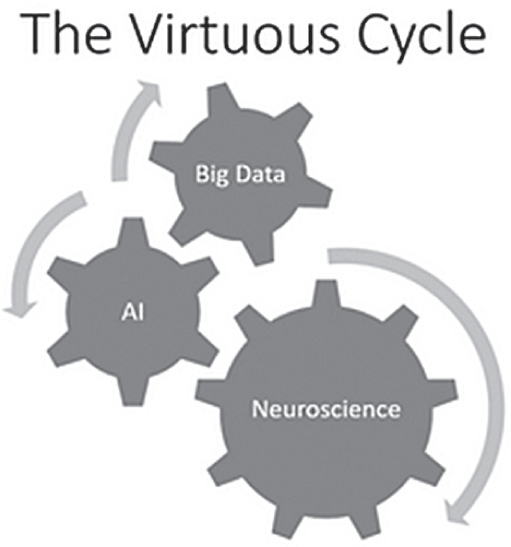
Make Your Learning Management System Smarter
The dawn is rising on another day, and everywhere you look, people are learning. Aisha works from home and is taking advantage of a quiet moment to catch up on some of her required computer security training. Her employer’s learning management system (LMS) has been reminding her, in increasingly shrill tones, that this training is overdue.
“ATTENTION! YOU HAVE PAST DUE TASKS,” screams the subject line, deploying the classic no-no of sending a message in all caps.
With a huge sigh, she drops what she is doing and logs in to her company LMS, hoping to escape the “naughty list,” which tells managers which employees have not completed mandatory training. Like most folks, she’s been putting it off because her previous experiences have all been painfully boring. But this time it’s different. The training feels like it’s been written just for her. It highlights security risks that are relevant to her job and presents scenarios that she faces every day. Because the content is so targeted to what she needs to know, it’s also a much shorter course than Aisha expected. When the system offers her another mandatory course, she decides to take that one, too, and enjoys a similar, personalized experience.
Harold is a sailor on board the USS Mercy, a Navy hospital ship. When he isn’t on duty, he’s also a college student, taking courses online via the ship’s Wi-Fi system. His program is an “open degree,” so he’s able to choose from courses offered at his own school, programs provided by the Navy or other schools, and even massive open online courses (MOOCs) from providers like Coursera and Teachable. He chooses his learning experiences from a curated list that was generated by an algorithm. As he completes items on the list, the system keeps track of completions by learning outcomes, rather than course numbers or titles. He’s progressing much faster toward his degree in electrical engineering with this approach, and he’s excited about the new career that is waiting for him after just three more learning outcomes are satisfied.
Halfway around the world, Sanjay is reviewing the results of his latest training project. His firm has invested in a new LMS with powerful analytics tools. At first, Sanjay was excited about the power this new system offered. But now, faced with myriad charts and graphs that appear to tell him every time each learner sneezed, he’s overwhelmed by the number of choices at his fingertips. How can he make sense of all this data? It will take him at least several hours to review just a single report. And how can he integrate all this information into something he can present to his boss? For a moment, he longs for the simpler days when the only reports he could run were course completions and quiz scores.
Alice is a retired systems administrator. She used to manage the IT department of a large public-school district, but she recently retired. Already comfortable with technology, she’s been indulging her passion for art by visiting the great galleries of Europe online. It’s all part of a course she’s taking just for her own enjoyment. Today she’s visiting the Louvre. Then she’s playing a nice round of golf with her friends.
Dave’s a deliveryman for a major online retailer. Today, he watched a demonstration of an experimental robot that can load the truck, program the self-driving vehicle to the customer’s address, unload the right package, and deliver it to their front door. Then the robot took a photo of the package to verify delivery and texted the customer. Placing a call to the customer’s mobile phone, the robot chirped, “Your package has arrived. Have a nice day,” The bot returned to the truck, started the self-driving program, and proceeded to the next location. Most of the people in the room were enchanted by this new technology, but Dave is worried about his job. He wonders if he should enroll in that coding class his boss mentioned to him.
Why are we fascinated by the next shiny thing? If you don’t have it yet, every new learning technology looks like the solution to all your problems. “If only we could have that [insert shiny new technology here], our training program would be so much more effective.” It’s possible that the next great thing is just around the corner and will transform our lives. But history reveals a different pattern.

“Students today can’t prepare bark to calculate their problems. They depend on their slates. … What will they do when their slate is dropped and it breaks? They will be unable to write!”
—Teachers’ Conference, 1703

“Students today depend too much upon ink. They don’t know how to use a penknife to sharpen a pencil. Pen and ink will never replace the pencil.”
—National Association of Teachers, 1907

“Students today depend upon store-bought ink. They don’t know how to make their own. When they run out of ink they will be unable to write words or ciphers until their next trip to the settlement.”
—Rural American Teacher, 1929

“Students today depend upon these expensive fountain pens. They can no longer write with a straight pen and nib (not to mention sharpening their own quills).”
—PTA Gazette, 1941

“Ball point pens will be the ruin of education in our country.”
—Federal Teacher, 1950

“There are still many … who worry that the calculator use will impair students’ mathematical ability and result in mathematical illiteracy.”
—School Superintendents’ Forum, 1997

“My mind now expects to take in information the way the Net distributes it: in a swiftly moving stream of particles. Once I was a scuba diver in the sea of words. Now I zip along the surface like a guy on a Jet Ski.”
—Nicholas Carr, “Is Google Making Us Stupid?,” 2008
If we don’t have the technology yet, we assume it will cure all our ills. If we have it, we see it as the source of all our troubles. Either way, we tend to assume that the technology itself is responsible for learning, losing sight of the fact that meaning is constructed in the brain of each learner. As Shakespeare’s Hamlet says, “There is nothing either good or bad, but thinking makes it so.”
In this chapter, we focus on how AI can enhance our human capital systems to support the learning process. It’s important to remember as we go through this chapter that these systems do not produce the learning experience itself. That’s created in the mind of the learners, one brain at a time.
Netflix Your Learning
The amount of data produced every single day continues to grow exponentially. In 2017, human beings generated 2.5 quintillion bytes of data a day—that’s 18 zeroes! As talent development professionals, how can we maintain high levels of performance in a time of unrelenting change? The solution is often called “lifelong learning,” but implementing it isn’t quite as simple as it seems. The learning profession is no longer about “checking the boxes” to satisfy some government or management requirements. It’s about applying science to transform the way people live their lives. When we do that successfully, the organization and society at large flourish. This sounds great, but how do you make it happen? One approach is a massive experiment that combines neuroscience, data analytics, and machine learning; there’s a good chance you’re already a willing subject.
Here’s how it works.
It starts with your brain. We have the brain we have for one reason—it keeps us alive. Our brain, along with the rest of our body, evolved to do one thing—preserve our species. One of the strongest survival traits we have is our desire to learn; we are fascinated by the new. We’re infatuated with puzzles, games, mysteries, and contests. When we figure something out, our brain gives us a powerful reward. It releases the chemical dopamine, which makes us feel great. When something feels great, like eating, exercising, or having sex, we tend to find opportunities to do that again. This chemical is so powerful that it can make you addicted. Once you get a taste, you’re always hungry for more.
Your brain uses the reward cycle to encourage you to perform lifesaving behaviors. One of those behaviors is learning, and we’re all addicted to it. In The Selfish Gene, Richard Dawkins sheds light on how the human brain evolved to be such a relentlessly effective survival machine, and how this single trait has so profoundly shaped our species.
Now gather a ton of data from a ton of brains. Netflix has more than 100 million subscribers and tracks these subscribers down to very specific behaviors (McFadden 2019). They know a lot about you: When you watch TV, what programs you watch, who else is in your family and what they watch, how you rate what you’ve watched, what you watch straight through and what you don’t finish, which titles you binge by watching multiple episodes in a row, what episodes you watch over and over again, and more. With the average American watching more than four hours of television a day, that’s a lot of data.
Set a machine loose on the data. If we had to analyze all that information with our brains alone, it would take years to recognize the patterns in just a small sample. Here’s where machine learning comes in handy. Algorithms are programs that tell a computer how to perform a task, such as recognize patterns and make predictions. These algorithms can often see patterns that would not be intuitive to even the most gifted human analyst.
Netflix uses data analytics algorithms to see patterns in individual users to make personalized recommendations. Then they connect those recommendations to users who have similar patterns to create new collections and categories that can be very specific. The prediction algorithm can also tell Netflix how their audience will respond to programming, such as which programs are likely to go viral within the first few minutes of viewing, and which programs are going to find a small but fiercely loyal, cult-like following. They’re using what we know about neuroscience to predict what sort of experiences will trigger the dopamine effect for each individual, and they have an algorithm to find the programming that triggers this response most effectively. Every time you select a program that Netflix recommends for you, you’re teaching the algorithm more about yourself, your preferences, and how you interact with and consume their content. They don’t have to attach a scanning device to your head to see the addictive rush you get from an absorbing online experience; your behavior gives you away every time. Each time the algorithm is used, it gets better at doing its job, so the predictions get better and better. The approach is called contextuality, and it creates the illusion of mass marketing content that feels uniquely selected to appeal to each individual customer because, behind the scenes, it actually was.
Sprinkle with social learning. Another trait that is hardwired into our DNA as a species is our need to learn from one another. Psychology Today magazine puts it simply: “People learn by watching other people.” Netflix and many other online marketers use this tendency to teach us which products, books, or programs to purchase by showing us the behavior of others. When we read a review on Yelp or check the number of “stars” before we make our selection, we’re letting the behavior of others help us make a decision. These “recommender systems” combine your own behavior (such as how you rated a similar program) with the behaviors of many other users, then filter for similarities between users so that in fact you are making recommendations to yourself.
Apply broadly and stir often. Of course, Netflix isn’t the only company that is deploying this approach to create a customized consumer experience on a massive scale. Amazon uses a predictive application that anticipates which products will be ordered a day before customers have even placed their orders, so that warehouses and distribution points can have the right supply of the right things to meet anticipated needs (Selyukh 2018). Google uses information from humans and machines to predict traffic congestion for Google Maps, and uses similar algorithms to predict your search terms before you’ve finished typing (Johnson 2019). The U.S. government uses AI to make predictions about enemy troop movements (Olckers 2020). NASA uses AI to predict when an astronaut is about to suffer too much fatigue to reliably pilot a spaceship (Shekhtman 2019). (All these examples rely on data sets of quality, reliable information. And lots of it.)
Apply AI to Analyze Big Data and Gain Big Insights
The fields of analytics and AI have evolved along convergent paths. About 30 years ago, business analytics consisted primarily of gathering and summarizing data. As analysis methods became more sophisticated, more specific business intelligence techniques allowed insights, predictions, and recommendations to be generated from the data collected. A few years later, data mining techniques were developed to automate the work of analyzing very large data sets—big data—to discover patterns that could predict the outcomes of business decisions. Most recently, the use of machine learning, AI, and other advances have allowed us to use intelligent machines to perform analytics without human direction.
AI and data analytics can be understood as a layered system, like the layers of an onion, with each successive layer becoming more and more complex. These layers include rule-based automated systems, machine learning, and deep learning.
Let’s peel back the onion one layer at a time.
Rule-based automation. A rule-based system allows us to build automation by leveraging domain-based knowledge. For example, we can use data on how humans process routine customer requests to automate the process using a text-based chatbot.
The automation works through explicit programming—if X happens, do Y. It relies on a huge database of domain knowledge, such as policies and procedures, and queries the data using keywords to determine the right course of action in a given situation.
Machine learning. As we’ve seen, machine learning is a subfield of AI that focuses on the ability to train a model to understand and predict the value of some quantity of new data for which the target value or classification is unknown.
Rather than tell the program how to do this, we allow it to learn from experience, by following the standards we set forth in the initial program. Then we let it continue to learn.
When we say “without intervention,” that’s not entirely true. The intervention takes place at the start of the process, when the rules are written that determine how the machine will learn. Human programmers write these rules. They tell the program how to sift through information—the source of the machine’s learning experience—to achieve certain goals, and what sources of information to use. Then they expose the program to huge amounts of data, and the learning begins. Let’s say you want to develop a program that can recognize cancer cells in magnetic resonance imaging (MRI) scans. The initial rules will describe how to identify a cancerous cell, along with numerous examples. Then we begin to expose the machine to scans without specifying the result. As the machine applies the rules, it receives feedback, whether its answers are correct or incorrect. It doesn’t take long for the machine to develop almost perfect performance. Now it’s time to subject the machine to raw data, for which the result is not yet known. Humans will continue to spot-check the results as quality assurance, but the machine now performs much faster and far more accurately than its human designers, so it increasingly becomes the standard for this type of analysis. Sound too futuristic to be true? It happened in 2019. What data-analysis needs does your organization face? You may be able to apply machine learning to gain new insights (Thomson 2020).
Although most corporate training departments and educational institutions are still on the fence about AI, China has jumped in with enthusiasm and is putting billions of dollars into what it calls “intelligent education” (Chawla 2019).
The initiative focuses on replacing or supplementing human teachers with robotic instructors that adapt to each student to provide personalized learning experiences. Some solutions use student performance to adjust the curriculum to an individual’s strengths and weaknesses, while others use biometric information, such facial expressions and voice inflection, to determine a student’s level of understanding and engagement with a virtual instructor.
Because of the large numbers involved, these programs are making great strides in the development of educational AI very quickly. Artificial intelligence systems require massive data sets in order to “learn” through experience with their human users. In 2017, one startup operating in China boasted more than 1 million users, who were working with the program five days a week, for the entire school day. That’s a lot of data, and a lot of potential machine learning.
In India, another market with access to massive numbers of students, the focus is also on using AI to replace the instructor in the classroom. In 2019 about 200 companies were providing AI solutions to deliver content and adjust the learning experience to individual performance (Tracxn 2019).
If you are working in corporate training, human resources, talent development, or any level of education, chances are you will be working with some version of intelligent artificial teachers or coaches in the very near future.
Deep learning. At the heart of the onion is deep learning (Figure 4-1). Deep learning is a complex branch of machine learning that uses neural networks designed to mimic the human brain, performing highly complex tasks with greater accuracy than other systems—and sometimes even humans—can produce. Because it is not given a pattern as a starting point, deep learning is capable of finding patterns and insights that would not be possible for machine learning or human analysis alone. These new insights are particularly valuable for predicting human behavior, which is where we come in (Dickson 2019).
Figure 4-1. Deep Learning at the Heart of AI and Data Analytics

What Is Big Data?
Data can mean just about anything that is created and shared. Consider your own experience. In a single hour, you might read an email on your PC, send a text on your phone, download a podcast, watch a video, and post a tweet. Each of these examples is a different type of data and requires different strategies for capture and analysis. And these are only a few examples of the diversity of data available online today. Big data doesn’t even have to be online. It can exist on secure servers or massive paper-based files that have been digitized.
Big data refers to data sets that are so voluminous and complex that traditional data-processing software is inadequate to deal with them. When organizations try to deal with these massive data sets, they often run into challenges, because we humans are just not built to handle the massive amount of information that we generate today. Big data has four dimensions, known as volume, variety, velocity, and veracity.
Volume
Volume refers to the staggering amount of information that must be present to qualify as “big.” The more data you can feed your algorithm, the deeper it learns and the more efficient and accurate it can become in predicting user behavior. Network behemoths like Google, Amazon, Netflix, and others are pulling data from billions or trillions of records from sources like websites, customer support centers, chatbots, social media, and e-commerce systems to generate these huge data sets. How big is big in this context? Data scientists work with petabytes (1,024 terabytes) or exabytes (1,024 petabytes) in applications like this.
Variety
Another characteristic of big data that makes it an interesting challenge for AI is the combination of different types of information in the same set, requiring a lot of processing power and understanding to interpret it. For example, a human being might be able to correlate information from when trains arrive at the station and how many passengers get off, but if we wanted to factor in weather, track conditions, and days of the week, we’d end up with a pretty unwieldy spreadsheet. Traditional data analysis tends to focus on information that is discrete—it is bounded by very specific rules that can be fit into a simple framework. We call this “structured data.” Test scores, completion rates, and course registrations fit into this category.
By contrast, unstructured data doesn’t have a predictable set of rules. It could be a profile image of an employee, a verbatim comment about a course, or the biometric track a learner’s eyes follow as they study a screen in an e-learning course.
The combination of unstructured and structured data in the same analysis is what makes up the variety characteristic of big data.
Velocity
Data is coming at us from all directions, and it is coming faster every day. To benefit from big data insights, companies must be able to capture, analyze, and use this massive amount of information as quickly as it is coming in. Human beings alone could never keep up with this “fire hose” of information, so big-data solutions must include strategies to control and keep up with the speed of incoming data. These strategies employ artificial intelligence to process the flood of information almost as quickly as it is coming in. If the information isn’t coming at a feverish velocity, chances are it isn’t really a big data application.
Veracity
Data must also be accurate if our AI program is to produce useful insights. The degree of uncertainty will reflect the veracity (or lack of it) of the data. It’s a simple concept that is often summarized as GIGO in the IT world. “Garbage in, garbage out” applies to computer programming, data analytics, and education. It’s all about making quality inputs to achieve a quality result.
What Problem Are You Trying to Solve? Is AI the Answer?
It is important to remember that big data, AI, and other analytics capabilities are most useful when traditional analytics systems and software cannot adequately solve the problem. Big data does not replace traditional analytics (plain old number-crunching by human beings with spreadsheets)—both have different uses, depending on the problem you are trying to solve.
Until you find a significant problem to solve—one that is keeping folks in the C-suite up at night—you’re unlikely to get the funding and sponsorship to move forward with an AI initiative.
Don’t have that large a data set? You still have options. There are several tools available that tap into larger data sets and allow you to tailor reports to your needs. A list of resources to get you started is in the resources section of the Appendix.
Can your organization use the same approach to make predictions about LMS searches or learner course completion? That depends. It takes a lot of data to train a predictive algorithm, so this technology is usually seen in large organizations with tons of data points. (Hence the usage by Netflix, Amazon, and Google.) If you’re fortunate enough to work in a large organization, they are likely already using predictive analytics and machine learning to develop new products, make wise investments, provide customer support, and protect their systems against cyberattacks. Your talent development team may be able to tap into data scientists and AI developers in your organization to design an algorithm for your organization.
Or, you could just buy a smart LMS.
Can an LMS Be Smart?
In 2017, I wrote an article for ATD’s TD magazine, “The Near Future of Learning Automation: The Smart LMS.” Early iterations of the learning management system first started appearing in the 1970s to support a truly disruptive innovation that we now call “e-learning.” Since then, these two learning tools have grown up together, each evolving as the other pushed the envelope a bit further, creating an iterative path to innovation. As LMS technology made things easier to do, instructional designers found ways to use its features to enhance the learning experience. When instructional designers demanded more of the LMS, providers found a way to deliver better video support, new ways of tracking learning experiences, and a wider array of features to engage learners. Yet most of my clients tell me that their relationship with their LMS has been producing diminishing returns for years.
However, many modern LMS systems combine data analytics and AI/machine learning to do a lot more than spit out completion reports and Level 1 learner reaction survey results (Kirkpatrick and Kirkpatrick 2016). Today’s “smart LMS” is programmed to “learn” the skills that each individual employee needs to meet business goals. Algorithms tell the LMS computer code how to determine which skills are required, based on business objectives. The LMS then produces a customized learning plan for each employee based on gaps indicated by skill assessment results. No more writing assessments; you simply upload your existing content, and the system writes the questions. As business goals change, the LMS, guided by the underlying algorithms, adjusts immediately and changes learning plans as needed to fill the newly identified skills gaps. This new type of LMS has become possible only with the advent of machine learning. The algorithm provides detailed instructions that allow the LMS to discover the needs of the business and each individual in your organization. No matter how much things change, the system will continue to adjust learning plans automatically, responding to updating company objectives. Instead of trying to plan for every possibility, the “machine”—in this case, the LMS—“learns” what is needed by analyzing the data according to the instructions contained in the algorithm. You’ll find more tools for selecting and deploying these features in your LMS on the Resource Site.
The Virtuous Cycle of Data and AI
A virtuous cycle is a practice or process that is improved by its results. The smart LMS can deliver a virtuous cycle of continuous performance improvement by continually responding to learner needs based on performance. The more deeply you can connect the LMS to performance data and real-time support information, the stronger this virtuous cycle can become.

Reap the Benefits of the Smart LMS
We may eventually develop an even longer list of benefits for learning automation as we gain more experience with this new technology. For now, here are the top advantages I see for early adopters:
Shortened needs analysis process. The smart LMS will be able to help you conduct a needs analysis by delivering assessments based on existing content. If the employee doesn’t pass the assessment, and the skill is flagged for their current or future role, the LMS will add that training to the learning plan. Detailed reports can show you a snapshot of needed skills versus assessment scores for your entire organization, group, or individual. You should be able to spend less time on analysis and more time on developing content and robust learning experiences.
Making assessments part of the learning process instead of just checking a box. According to the U.S. Department of Education, assessments should be learning experiences. However, the typical standardized test is a poor instrument for achieving this end. The standardized multiple-choice test has its place in training and education, but it doesn’t really measure what society thinks it measures. A multiple-choice question measures how well the learner can guess at the answer by eliminating incorrect options and then choosing the most likely answer from the list of remaining choices. (Many machine learning programs operate the same way.)
While this is certainly a valuable work and life skill (suppose you have to choose something to eat for lunch from a menu of items you don’t usually eat), it isn’t a measure of how much you’ve learned. Because learning results in changing behavior, the only way to truly measure if someone has learned is to evaluate their behavior under a controlled set of constraints. If someone has already demonstrated mastery of a particular skill in previous lessons, for example, there is no need to have them repeat that performance on the final exam.
In today’s digital era, recall is often no longer a relevant requirement for education and training. Nearly everything we need to “know” can be found online. What we need to be able to do is apply that information effectively on the job or in school. By tracking where an individual is struggling, the system can provide targeted review content and continually measure improvement, linking the learning experience to on-the-job performance. An LMS empowered with artificial intelligence can become the perfect teacher, always ready with a new tip or a challenging question.
For example, Pearson, the textbook publisher, has an AI-driven English-language assessment tool (English Benchmark) that can use a student’s spoken or written input to:
• Assess where the student is in their development.
• Identify gaps in their knowledge.
• Select learning activities to close those gaps.
• Reassess on a continuous basis to fine-tune the learning.
The product is aligned with the Global Scale of English (GSE) and the Common European Framework of Reference for Languages (CEFR) and uses an algorithm to adapt to the needs of each individual learner. The algorithm uses a specialized type of natural language processing called latent semantic analysis, which can analyze and score writing based on the meaning behind words—and not just their superficial characteristics. This approach helps us determine how well the student recognizes the contextual meaning of words, which vary depending on the rest of the words in the sentence.
While the Pearson tool is focused on one particular subject, the assessment-learning-assessment cycle could be applied to any academic subject or job competency.
When businesses and schools all over the world closed as part of the effort to slow the spread of the coronavirus, we experienced firsthand the need for a nimble response to unexpected changes that affect the learning process. On a smaller scale, these pivots are happening all the time, and a smart LMS can help you meet those demands. For example, if your company decides that your customer care team needs to start making sales during inbound calls, you need to be able to update the program to address the new skills required to assess, teach, and support those goals.
We’ve been talking about personalized learning for decades, and the technology has finally caught up. Because no two people are alike, no two employees will have exactly the same learning plan, even if they are serving in the same role.
When employees receive learning suggestions that are truly customized to them, they will probably respond with more excitement about their work and a greater appreciation for the company that has invested so sincerely in their future. While this new type of LMS will likely appeal to all learners, Millennials are already demanding this sort of customized approach, which mirrors their experience as consumers.
Buy a Smart LMS Smartly
Learning management systems don’t come cheap, so this is an AI-enabled technology that may take some time to acquire. Like any other major purchase, start by defining your goals, then look for a platform that supports those goals most effectively. Only you can decide what you want in a smart LMS, but here’s what training managers said they’re looking for, according to a recent survey by LMS provider Docebo:
• data analytics (50 percent)
• social/collaborative tools (44 percent)
• mobile delivery (43 percent)
• content management (37 percent)
• virtual classrooms (35 percent).
Plan for Your Next LMS Now
We can teach calculus, music, marketing, French, or anything else using any type of technology. We could even just talk about the subject. Marshall McLuhan is famous for saying “The medium is the message,” in reference to what was then the new entertainment medium of television. But when I try to extrapolate that concept to today’s breathless excitement about learning technologies, it feels empty. Is Twitter the message? Facebook? YouTube? If we’re able to do anything at all, we learning professionals can help an individual find their own way toward meaning. We don’t need the latest and greatest of anything to make that happen. The key is to start by using the tools at hand. And when better tools become available, use those, too. No shiny new tool is going to do the hard work for us, so having an out-of-date LMS is no excuse for delivering an antiquated learning experience. Conversely, buying a new shiny thing won’t absolve us of our responsibility to apply what we know to create an exciting, engaging, supportive approach that provides a personalized journey for each learner.
Two things are highly likely at this moment:
• Your current LMS is at least a bit outdated.
• You have a new LMS somewhere in your future.
Look for These Features in Your Next LMS
As described in the 1950s by the father of modern computer science, Alan Turing, “What we want is a machine that can learn from experience” (Turing 1950). This description fits the concept of a smart LMS very well. With each learner, the smart LMS should be able to get better at making personalized recommendations, linking learning experience to key performance indicators (KPIs), and delivering assessments that measure the learner’s ability to do their job, rather just measuring their success in multiple-choice tests. In an article for HR Technologist, researcher Annabelle Smyth summarized several key benefits to gain from an AI-enabled LMS.
Smart Curation
With AI in the mix, e-learning platforms can offer smart curation and personalization features, which will enable learners to study at their own pace and in the style that suits them. Using predictive modeling, AI can create anticipated learning paths by monitoring a learner’s performance and adjust the path so that it never becomes too daunting or too slow for immersion to take place (the “Goldilocks Zone”) (Dawson 2019).
Likewise, AI can suggest which lessons to take next and how frequent testing should be, and offer guidance in terms of which courses the learner should tackle to achieve the next level of performance. This level of personalization will allow e-learning platforms to rise above the competition and ensure that individuals are satisfied with the amount of information and skills they’ve accumulated from using them.
In 2020, I asked a design analyst for the learning consulting firm Aptara to summarize what trends they are seeing with their clients. Here’s what I learned. “Organizations are adopting platforms that use AI to customize content for specific learner needs. These same systems also use machine learning by mining the data generated by learners using the system to customize learning experiences. As learning grows beyond knowledge silos, and the knowledge acquisition required is by nature cross-functional, such systems will deliver the knowledge required to the learners.”
In a research report, the Association for Talent Development makes this recommendation:
“Review features that support personalization and enable adaptation when evaluating new products or upgrades to existing systems” (ATD Research 2018).
Conversational Interface
As with other AI applications, the use of natural language programming allows the learner experience to be more engaging and personalized. For example, a digital voice assistant similar to Alexa and Siri can create a completely different experience from typing keywords into a search window to find appropriate learning experiences (see chapter 3).
Linking Performance Support
Sometimes you can’t wait for the learner to make incremental improvements—you need them to perform correctly on the job. If I have a new technician in the field, I don’t want them to learn through trial and error while they make mistakes with my customers. A performance support module can deliver just-in-time support, from simple tips to detailed, step-by-step instructions. The data captured during actual on-the-job performance can then be used to suggest remedial training that can be consumed at a more convenient time.
One of my clients uses an augmented reality overlay that tracks how the user is moving through the system and provides tips for those areas where the user appears to be hesitating or struggling. The system can even offer to “walk through” the process, delivering step-by-step instructions until the learner demonstrates the confidence to work on their own. The key is to avoid slowing down employees who are already competent in the skill while providing support for those who need it, so the algorithm learns how to recognize individual users and match their performance against the pattern of highly skilled users, identifying where these individuals will need additional help. With new employees, the machine might be in almost constant communication, avoiding errors and reinforcing key steps and tips. Over time, as the employee gains more confidence, these tips become fewer, coming up only occasionally.
Using AI in the Recruiting Process
So far, we’ve talked about what AI can do to support your employees once they are through the door. The truth is, AI’s influence begins long before that first day on the job. One of the earliest applications for AI and machine learning has been in the recruiting process, and it’s getting better all the time. Today most jobseekers post their résumés and other personal details online and subscribe to various social media tools to help them apply to hot jobs as they appear. What they may not realize is that employers are using these same tools to find them—or eliminate them from consideration. Large companies can use AI in a number of ways to sift through available candidates and come up with a small list of finalists for serious consideration. Jobseekers and resumes that don’t make the cut never connect with a human being; the decision to move on to someone else has already been made by an algorithm. Here are a few applications that have already made their way into the workplace:
Find Qualified Candidates and Get Them Interested in Your Company
An AI application can be trained to sift through all the resumes online to find the skills and experiences that represent likely success on the job. That’s the easy part, and AI has been doing the heavy lifting for this part of the process for years. The latest innovation reaches out to the candidates through email or social media and engages them. In many cases, a top candidate will receive inviting emails or social media messages before they have even considered working for a particular company. They will be wooed by an AI. And based on the rich amount of information available on each of us online, the AI has plenty of material to use to weave a cohesive campaign that feels customized to the individual candidate, because it is.
The process can also be extremely efficient, sifting through thousands of candidates to find the few who are the best fit for the job. In fact, that very speed can be a challenge sometimes. One hiring company that deployed an AI-enabled program to identify key candidates had to build some delay into the process. It seems that candidates were getting responses from the system so quickly that they didn’t trust the results and questioned the validity of the system (McIlvaine 2020).
Re-engage Previous Candidates
Sometimes an applicant doesn’t work out for a particular job. Even though they didn’t make the final cut, these people are often highly qualified, and they already expressed an interest in the company. While a human recruiter might lose track of these individuals, a machine never forgets. AI programs can stay in touch with candidates who were turned down. Through a process called “talent rediscovery,” the system automatically matches new opportunities to everyone in the database and keeps track of updated skills, all running in the background without an interruption. When the right match comes along, the candidate receives an invitation to apply. It’s rewarding to the individual, who feels valued and respected by the potential employer, and it saves a lot of time and effort not having to vet a completely new person in the pipeline.
Match Candidates to the Right Jobs
I once got a call from a recruiter for a job I didn’t apply for. It seems that I had applied for a job that wasn’t such a good fit for my skills, but the recruiter had something else that was right up my alley. I was lucky that this human being saw my untapped potential at the time. Now that same recognition might be driven by the pattern recognition of an AI, matching candidates to potential jobs, regardless of what they originally applied for. In these instances, our machines sometimes know us better than we know ourselves.
Reimagine the Pre-employment Assessment
Many employers are using pre-employment screening, such as aptitude tests, to help narrow the field. To appeal to younger candidates, many of these screening activities are presented as games or social media “communities” that encourage participants to learn more about the company and engage with existing employees and fellow applicants. While these pre-employment activities are delivering on their promise, they are also beginning the evaluation process. Applicants will reveal a great deal about themselves and their communication skills, problem-solving approach, technical aptitude, and social skills in these activities, and all of this information produces additional data for the AI to use in the evaluation process.
Hiring organizations need to be wary of legal considerations that may put them at risk for litigation, fines, or prosecution. In the United States, for example, Title I of the Americans With Disabilities Act (ADA) makes it illegal for employers to use employment-screening tests that discriminate against qualified applicants based on their mental or physical disabilities.
Train Your Dragon Carefully
You might be surprised to see training as an AI-related term. In this context, it refers to the preliminary process of machine learning, during which the system is exposed to a wide range of variables to discover the standards and patterns it will use to make predictions and recommend actions. The AI then uses this model to make predictions based on new information that it encounters. In layman’s terms, the system teaches itself and then applies what it has learned to the environment, continuously modifying the model as it goes. (Sound familiar? “Reward learning” is a concept borrowed from cognitive psychology and applied to the learning process of a neural network made of silicon, instead of carbon.)
In a famous example of (presumably) unintended consequences of machine learning, Microsoft introduced the chatbot Tay on Twitter in 2016. Within 24 hours, the AI had learned how to spew some of the most vile, racist, misogynistic language imaginable and had to be put down. The reason for the failure can be found in the way we train AIs—on huge data sets. Tay was simply put online and programmed to “listen and respond” to what was being posted online (Vincent 2016).
I’m reminded of the film How to Train Your Dragon:
“Dragons can’t change who they are. But who would want them to? Dragons are powerful, amazing creatures. … Most people … would say life here is better since we made peace with them. Unfortunately, dragons are still, well, dragons.”
The LMS Is Not the Learning
The brain is constantly rewiring itself in response to changes detected in our environment. This remarkable capability, called neuroplasticity, tells us two important things.
First, behavior change is always possible. In fact, it is nearly unavoidable, given the onslaught of information rushing into our brains through our senses.
Second, as talent development professionals, we don’t actually produce learning. We give people the framework and opportunity to learn, but they do the learning all by themselves. That’s because each brain is unique—shaped by a constant stream of unique experiences and conscious choices of what to pay attention to and what to ignore or treat as background noise.
Sounds simple, doesn’t it? But consider this: Every single behavior, pattern, belief, habit, superstition, bias, or preference that contributes to the person you know as you is a result of your unique experience. You have been building your own neural connections since before you were born, and you continue to tinker with your completely unique creation every single minute of your life—even when you are asleep.
The hard truth is that no training program or LMS changes behavior. I’ll say that again, because you might not believe me. No course, training program, or LMS has ever changed behavior. That’s because we training professionals don’t own the learning process; our learners do. We can set up a situation in which people are more likely to choose to change behavior, but only the learner can actually make the choice to change, and then take the steps to put that change into effect. So the real question is, “How can we set the stage for behavior change?” Technology can help, but it can’t make it happen.
I’ve provided a few tools in the back of the book and the Resource Site to help you make the most of your learning technology, but the learning process itself is between you and each individual you serve as a learning professional. The resources you’ll find include:
• Build It or Buy It?
• Do You Really Need an LMS? A job aid with a few questions you should ask before you invest in an LMS at all.
Chapter Summary
This chapter focused on pairing AI with a familiar tool for delivering and measuring training, the learning management system. This chapter provided:
• tips on how to make your learning content “binge worthy” using the AI-driven techniques employed by Netflix, Amazon, Google, and other organizations that have become experts at personalizing the customer experience
• a look at the levels of AI, from rule-based automation to deep learning
• an overview of the four dimensions of big data and how it provides the necessary framework for machine learning
• the characteristics of an AI-enabled “smart LMS” and how to buy one
• a word of caution about the limits of what any technology can do to support the learning process.
You’ll also find a list of tools in the back of the book and on the Resource Site.
Technology has come a long way in our profession, and AI promises to take it even further very quickly. With that speed comes a terrible responsibility that we need to discuss: How can we control this stunning new technology, and make sure that we’re doing the right thing? That’s exactly the question we address in chapter 5: “Do the Right Thing.”